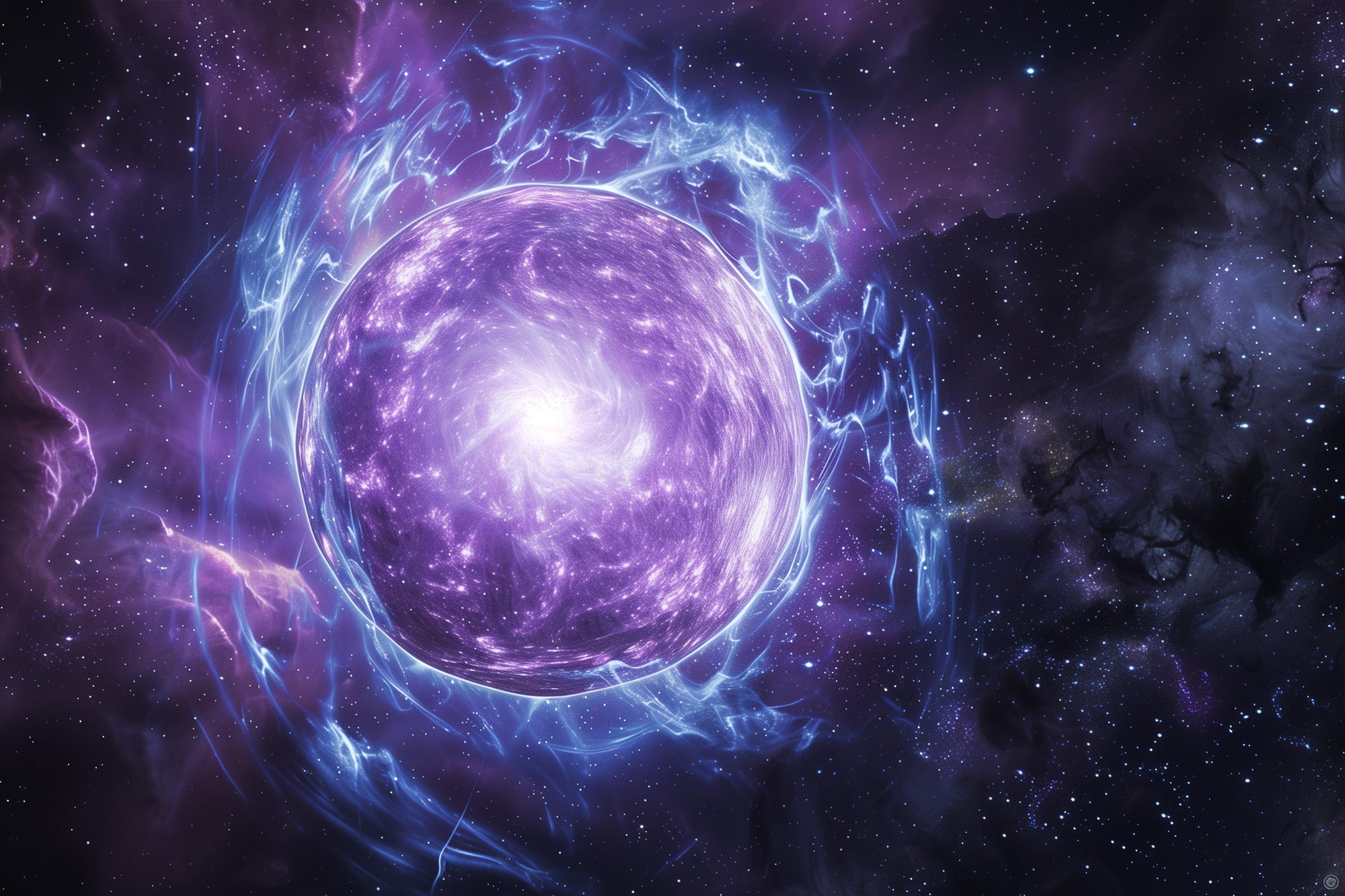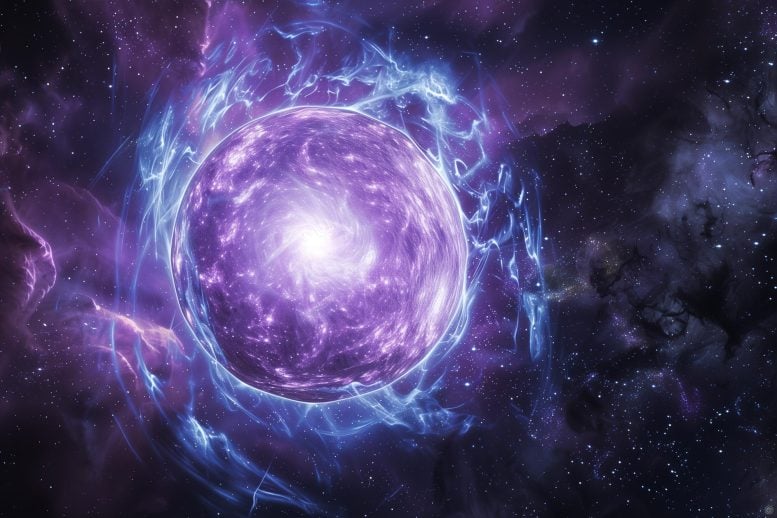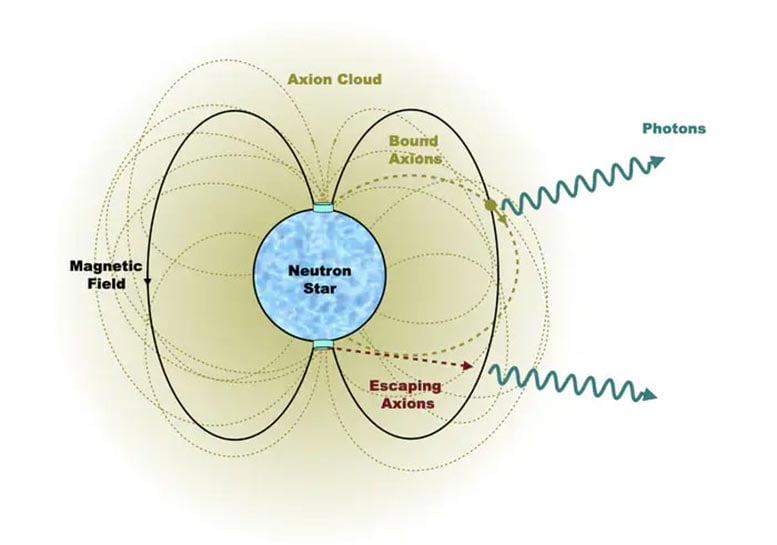

Physicists have proposed that axions, theoretical particles that could explain dark matter, may accumulate in dense clouds around neutron stars due to their strong gravitational fields.
Recent studies suggest these axion clouds could eventually be observable through their interactions with electromagnetic fields, transforming into light. This research offers a promising new method to detect dark matter by observing these emissions with radio telescopes, marking an important advance in both theoretical physics and astronomy.
A team of physicists from the universities of Amsterdam, Princeton, and Oxford has discovered that extremely light particles called axions may form large clouds around neutron stars. These axions could potentially explain dark matter, one of the most elusive mysteries in cosmology, and might even be easier to observe than previously thought.
Their findings, recently published in Physical Review X, build on earlier research. In their previous work, the team studied axions that escape from neutron stars. However, this new study shifts focus to the axions that remain trapped by the star’s intense gravity. Over time, these particles are expected to form a hazy cloud around the neutron star, and it appears that these clouds could be detectable with current telescopes. But why are astronomers and physicists so keen to study these distant, hazy clouds?

Unveiling the Nature of Axions
Protons, neutrons, electrons, photons – most of us are familiar with the names of at least some of these tiny particles. The axion is lesser known, and for a good reason: at the moment it is only a hypothetical type of particle – one that nobody has yet detected. Named after a brand of soap, its existence was first postulated in the 1970s, to clean up a problem – hence the soap reference – in our understanding of one of the particles we could observe very well: the neutron. However, while theoretically very nice, if these axions existed they would be extremely light, making them very hard to detect in experiments or observations.
Today, axions are also known as a front-running candidate to explain dark matter, one of the biggest mysteries in contemporary physics. Many different pieces of evidence suggest that approximately 85% of the matter content in our Universe is ‘dark’, which simply means that it is not made up of any type of matter that we know and can currently observe. Instead, the existence of dark matter is only inferred indirectly through the gravitational influence it exerts on visible matter. Fortunately, this does not automatically mean that dark matter has no other interactions with visible matter at all, but if such interactions exist their strength is necessarily tiny. As the name suggests, any viable dark matter candidate is thus incredibly difficult to directly observe.
Putting one and one together, physicists have realized that the axion may be exactly what they are looking for to solve the dark matter problem. A particle that has not yet been observed, which would be extremely light, and have very weak interactions with other particles… could axions be at least part of the explanation for dark matter?
Neutron Stars and Axion Detection
The idea of the axion as a dark matter particle is nice, but in physics an idea is only truly nice if it has observable consequences. Would there be a way to observe axions after all, fifty years after their possible existence was first proposed?
When exposed to electric and magnetic fields, axions are expected to be able to convert into photons – particles of light – and vice versa. Light is something we know how to observe, but as mentioned, the corresponding interaction strength should be very small, and therefore so is the amount of light that axions generally produce. That is, unless one considers an environment containing a truly massive amount of axions, ideally in very strong electromagnetic fields.
This led the researchers to consider neutron stars, the densest known stars in our Universe. These objects have masses similar to that of our Sun but compressed into stars of 12 to 15 kilometers in size. Such extreme densities create an equally extreme environment that, notably, also contains enormous magnetic fields, billions of times stronger than any we find on Earth. Recent research has shown that if axions exist, these magnetic fields allow for neutron stars to mass-produce these particles near their surface.
Persistent Axion Clouds
In their previous work, the authors focused on the axions that after production escaped the star – they computed the amounts in which these axions would be produced, which trajectories they would follow, and how their conversion into light could lead to a weak but potentially observable signal. This time, they consider the axions that do not manage to escape – the ones that, despite their tiny mass, get caught by the neutron star’s immense gravity.
Due to the axion’s very feeble interactions, these particles will stay around, and on timescales up to millions of years they will accumulate around the neutron star. This can result in the formation of very dense clouds of axions around neutron stars, which provide some incredible new opportunities for axion research. In their paper, the researchers study the formation, as well as the properties and further evolution, of these axion clouds, pointing out that they should, and in many cases must, exist.
In fact, the authors argue that if axions exist, axion clouds should be generic (for a wide range of axion properties they should form around most, perhaps even all, neutron stars), they should in general be very dense (forming a density possibly twenty orders of magnitude larger than local dark matter densities), and because of this they should lead to powerful observational signatures.
The latter potentially come in many types, of which the authors discuss two: a continuous signal emitted during large parts of a neutron star’s lifetime, but also a one-time burst of light at the end of a neutron star’s life, when it stops producing its electromagnetic radiation. Both of these signatures could be observed and used to probe the interaction between axions and photons beyond current limits, even using existing radio telescopes.
Exploring Future Axion Studies
While so far, no axion clouds have been observed, with the new results we know very precisely what to look for, making a thorough search for axions much more feasible. While the main point on the to-do list is therefore ‘search for axion clouds’, the work also opens up several new theoretical avenues to explore.
For one thing, one of the authors is already involved in follow-up work that studies how the axion clouds can change the dynamics of neutron stars themselves. Another important future research direction is the numerical modeling of axion clouds: the present paper shows great discovery potential, but there is more numerical modeling needed to know even more precisely what to look for and where. Finally, the present results are all for single neutron stars, but many of these stars appear as components of binaries – sometimes together with another neutron star, sometimes together with a black hole. Understanding the physics of axion clouds in such systems, and potentially understanding their observational signals, would be very valuable.
Thus, the present work is an important step in a new and exciting research direction. A full understanding of axion clouds will require complementary efforts from multiple branches of science, including particle (astro)physics, plasma physics, and observational radio astronomy. This work opens up this new, cross-disciplinary field with lots of opportunities for future research.
Reference: “Axion Clouds around Neutron Stars” by Dion Noordhuis, Anirudh Prabhu, Christoph Weniger and Samuel J. Witte, 17 October 2024, Physical Review X.
DOI: 10.1103/PhysRevX.14.041015